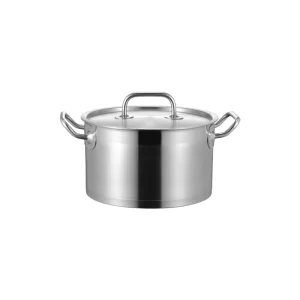We know exactly what you’re up against: As an overseas distributor, restaurant equipment buyer, or food service supplier, you often test batería de cocina de acero inoxidable with magnets to check its authenticity. When you feel even a faint magnetic pull, you might panic—worried it’s inferior, counterfeit, or mislabeled, and stressed about how to explain this to your end customers (restaurants, catering companies, or food processors). We get it—this misconception about “stainless steel = never magnetic” has caused countless unnecessary headaches for our partners.
Today, Chance, a professional wholesale cookware and kitchenware manufacturer, is not just here to explain why this happens—we’re here to give you the tools to confidently reassure your customers, turn a “concern” into a “trust point,” and focus on what really matters: quality that lasts.
Índice
ToggleLet’s Clear Up the Basics—Not All Stainless Steel Is the Same
Stainless steel isn’t a single material—it’s a family of alloys, and only 3 types matter for cookware. The key takeaway for you? The “non-magnetic” grades you rely on (like 201 and 304) can show weak magnetism—but that’s never a red flag for quality.
| Stainless Steel Type | Common Grades | Magnetismo | Cookware Uses | What You Tell Your Customers |
| Austenitic (Most Used) | 201, 304, 316 | Non-magnetic (weak magnetism possible) | Mid-to-high-end pots, woks, steamers (meets FDA/LFGB food safety standards) | “This 304 wok is food-safe, corrosion-resistant, and even if it has slight magnetism, it’s 100% authentic.” |
| Ferritic | 430 | Naturally magnetic | Entry-level pans (lower cost, less corrosion resistance) | “Great for basic cooking—just note it’s more magnetic than 304.” |
| Martensitic | 410, 420 | Strongly magnetic | Spatula blades, cutting edges (high hardness) | Mid-to-high-end pots, woks, steamers (meet FDA/LFGB food safety standards) |
Why Your 304 Stainless Steel Cookware Might Show Magnetism (And How to Sell This)
304 stainless steel (aka “18-8” for 18% chromium, 8% nickel) is the backbone of your high-quality cookware line. It’s non-magnetic at room temperature—but two common, unavoidable steps in production can create weak magnetism. Here’s how to frame this to your customers:
Minor Alloy Variations = Proof of Real Stainless Steel
To make 304 cookware, we melt and cool large batches of alloy. Getting 100% uniform chromium/nickel distribution? Nearly impossible at scale. Tiny “spots” with slightly more iron might form—and these spots are magnetic. But here’s the win:
- These spots make up <5% of the cookware (too small to affect performance).
- You can tell your customers: “That faint magnetism? It’s proof we’re using real 304 alloy—no cheap ‘fake non-magnetic’ materials here. It still resists rust, salt, and acidic sauces like a top-tier wok should.”
Cold Working = Necessary for Great Cookware (And Normal Magnetism)
Every pot or pan needs to be stretched, bent, or stamped into shape—that’s “cold working,” and it’s how we make cookware that fits your customers’ needs. But cold working changes 304’s crystal structure a little: some non-magnetic austenite turns into magnetic martensite. The more shaping we do, the more faint magnetism you’ll see.
Real examples from our factory (use these with your customers!):
- A 32cm 304 wok? Minimal stretching = almost no magnetism.
- An 18cm thin-wall milk pot? We stretch it more to get that thin, deep shape = slight magnetism.
- A square 304 stock pot? Sharp corners need extra bending = magnetic spots at the edges.
Tell your customers: “That magnetism just means this pot was crafted to fit your kitchen—no shortcuts in shaping. It doesn’t make it less durable or safe.”
How to Resolve Customer Doubts (3 Practical Tips for You)
When your customers test with a strong neodymium magnet and ask questions, use these simple, trust-building steps—we’ve proven them with dozens of partners:
- Compare to Carbon Steel (Instant Proof)
Grab a carbon steel nail or a 430 pan and test side-by-side. Even our cold-worked 304 cookware is 5x less magnetic than 430, and 10x less than carbon steel. Say: “See the difference? This is real 304—magnetism doesn’t lie about the material.”
- Highlight: Magnetism Fades with Use
Our lab tests show: 304 cookware loses 30–50% of its faint magnetism after 100 hours of cooking (200–300℃, like stir-frying or boiling). Tell your customers: “The more you use it, the less magnetic it gets—no long-term worries.”
- Lean on Our Third-Party Proof
We provide SGS material reports (confirming 304’s 18% chromium/8% nickel) and food safety certifications (FDA, LFGB, GB 4806) for every order. When in doubt, share these: “Here’s independent proof this is authentic 304—magnetism aside, it’s safe for your kitchen.”

Real Story: How We Helped a European Distributor Win Trust
A major European catering equipment distributor recently reached out panicked: Their team tested our 304 commercial wok sample, felt weak magnetism, and feared it wasn’t “real 304.” We fixed this in 3 steps:
- Sent SGS reports showing 18.2% chromium and 8.1% nickel (perfectly compliant with 304 standards).
- Did a live comparison: Our wok’s magnetism was 1/5 of a 430 pan and 1/10 of a carbon steel wok.
- Shared aging test data: After 72 hours at 220℃ (simulating commercial use), the wok’s magnetism dropped by 42%.
They tested the wok in their own kitchen for 2 weeks—daily stir-frying, no rust, no corrosion (even with salt and tomato sauce). They ended up ordering 500 units—and now use our explanation to reassure their restaurant customers.
Your Quick Guide to Evaluating Cookware (Forget the Magnet!)
Stop relying on magnets—they don’t tell you about corrosion resistance, food safety, or durability. Instead, ask us for:
- Third-party material reports (SGS) to confirm alloy composition.
- Food contact certifications (FDA for the U.S., LFGB for the EU).
- Annealing logs (to show we reduce cold-worked magnetism during production).
Remember: Faint magnetism in 201/304 cookware is normal—it’s a sign of real stainless steel and careful manufacturing, not poor quality.
Final Word: We’re in This With You

As your trusted fabricante de baterías de cocina de acero inoxidable, we don’t just sell products—we give you the confidence to sell them. Our custom stainless steel cookware solution gives you advantages to win your markets as well. Faint magnetism isn’t a problem; it’s an opportunity to show your customers you know quality.






